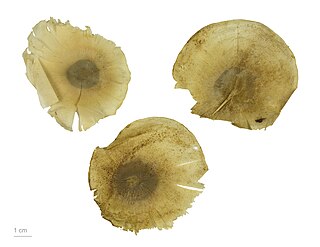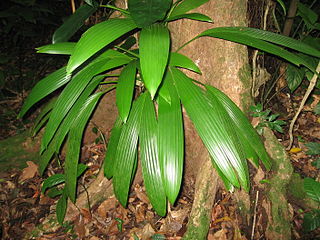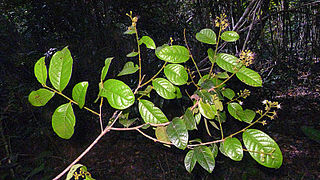
The Guiana Shield is one of the three cratons of the South American Plate. It is a 1.7 billion-year-old Precambrian geological formation in northeast South America that forms a portion of the northern coast. The higher elevations on the shield are called the Guiana Highlands, which is where the table-like mountains called tepuis are found. The Guiana Highlands are also the source of some of the world's most well-known waterfalls such as Angel Falls, Kaieteur Falls and Cuquenan Falls.

Hevea is a genus of flowering plants in the spurge family, Euphorbiaceae, with about ten members. It is also one of many names used commercially for the wood of the most economically important rubber tree, H. brasiliensis. The genus is native to tropical South America but is widely cultivated in other tropical countries and naturalized in several of them. It was first described in 1775.
Micrandra is a plant genus of the family Euphorbiaceae first described in 1854. It is native to South America.

Pouteria is a genus of flowering trees in the gutta-percha family, Sapotaceae. The genus is widespread throughout the tropical Americas, with outlier species in Cameroon and Malesia. It includes the canistel, the mamey sapote, and the lucuma. Commonly, this genus is known as pouteria trees, or in some cases, eggfruits.

Caryocar is a genus of flowering plants, in the South American family Caryocaraceae described as a genus by Linnaeus in 1771. It is native primarily to South America with a few species extending into Central America and the West Indies.

Aspidosperma is a genus of flowering plant in the family Apocynaceae, first described as a genus in 1824. It is native to South America, Central America, southern Mexico, and the West Indies.

Asplundia is a genus of plants belonging to the family Cyclanthaceae. They are distributed in the Neotropical realm from southern Mexico to southern Brazil.

Eschweilera is a genus of woody plants in the family Lecythidaceae first described as a genus in 1828. It is native to southern Mexico, Central America, South America, and Trinidad.

Lecythis is a genus of woody plant in the Lecythidaceae family first described as a genus in 1758. It is native to Central America and South America. Several species produce edible seeds and referred to by a variety of common names including paradise nut, monkey pot, cream nut, and sapucaia nut.

Micropholis is group of trees in the family Sapotaceae, described as a genus in 1891.

Hirtella is a genus of 110 species of woody trees in family Chrysobalanaceae. It was first described as a genus by Linnaeus in 1753. Hirtella naturally occurs in tropical forests throughout Latin America, the West Indies, southeast Africa, and Madagascar. The flowers are mainly pollinated by butterflies.

The following outline is provided as an overview of and topical guide to South America.

Montrichardia is a genus of flowering plants in the family Araceae. It contains two species, Montrichardia arborescens and Montrichardia linifera, and one extinct species Montrichardia aquatica. The genus is helophytic and distributed in tropical America. The extinct species M. aquatica is known from fossils found in a Neotropical rainforest environment preserved in the Paleocene Cerrejón Formation of Colombia. Living Montrichardia species have a diploid chromosome number of 2n=48.

Piresia is a genus of South American plants in the grass family.
- Piresia goeldiiSwallen - French Guiana, Suriname, Venezuela (Amazonas), Colombia (Amazonas), Ecuador, Peru (Loreto), Brazil
- Piresia leptophyllaSoderstr. - Colombia (Amazonas), Ecuador, Peru, Brazil(Pernambuco, Amazonas, Bahia), Trinidad & Tobago
- Piresia macrophyllaSoderstr. - French Guiana, Peru, Brazil
- Piresia palmulaM.L.S.Carvalho & R.P.Oliveira - Brazil (Bahia)
- Piresia sympodica(Döll) Swallen - Venezuela, French Guiana, Suriname, Guyana, Colombia, Ecuador, Peru, Brazil, Trinidad & Tobago

Chamaecostus cuspidatus, common name fiery costus or spiral flag, is a species of herbaceous plant in the family Costaceae native to eastern Brazil. In India, it is known as insulin plant for its purported anti-diabetic properties.

Ischnosiphon is a genus of plants native to Central America, South America, Trinidad and the Lesser Antilles. It was first described as a genus in 1859.

Schiekia is a genus of herbs in the family Haemodoraceae, first described as a genus in 1957. It contains only one recognized species, Schiekia orinocensis, native to South America. This plant grasped the minds of many scientists who tried fruitlessly to discover its purpose in the natural order.

Dimerocostus is a group of flowering plants in the Costaceae described as a genus in 1891. It is native to Central and South America.

Rapatea is a group of plants in the family Rapateaceae described as a genus in 1775.


















